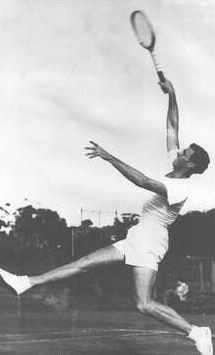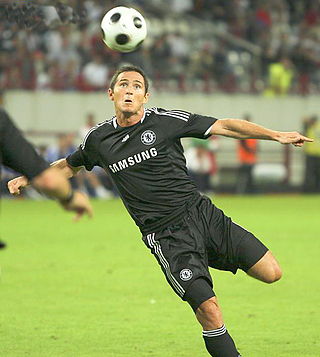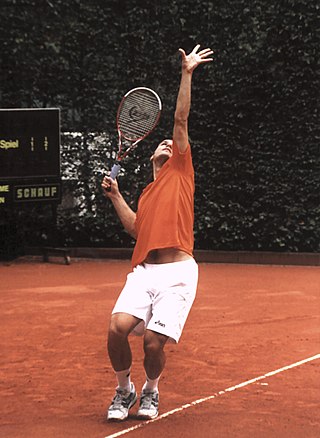A half volley in tennis is a shot that is hit immediately after the ball bounces but before it reaches the apex of its bounce. It is sometimes called an "on the rise shot", or "short hop".
The player who is hitting the half volley should not take a full backswing, but should still follow through. The grip for this shot is a standard continental. Also, staying down when hitting the shot is very important, or else it will go long. This is the basic form for the volley, hence the name: half volley. The two parts of the tennis court where this shot is generally used are on the baseline and the service line.
A half volley is a difficult shot to make. Often a player hits a half volley only when forced by the opponent or caught out of position.
The half-volley came to prominence in the hands of George Caridia and Ernest Lewis in the early 1900s. [1] Arguably the greatest half-volleyer in history is John McEnroe; other professionals such as Stefan Edberg, Pete Sampras and Roger Federer had excellent half volleys that were used as weapons.
In his 1979 autobiography Jack Kramer devotes a page to the best tennis strokes he had ever seen. He writes: "HALF-VOLLEY—Gonzales and Rosewall. Kenny had to learn to hit a half-volley because his serve was so weak that he had to pick up shots at his feet as he came to the net. With his great serve, I don't know why Gorgo had to hit so many half-volleys, but he sure learned how."

Tennis is a racket sport that is played either individually against a single opponent (singles) or between two teams of two players each (doubles). Each player uses a tennis racket that is strung with cord to strike a hollow rubber ball covered with felt over or around a net and into the opponent's court. The object of the game is to manoeuvre the ball in such a way that the opponent is not able to play a valid return. The player who is unable to return the ball validly will not gain a point, while the opposite player will.

Real tennis – one of several games sometimes called "the sport of kings" – is the original racquet sport from which the modern game of tennis is derived. It is also known as court tennis in the United States, formerly royal tennis in England and Australia, and courte-paume in France. Many French real tennis courts are at jeu de paume clubs.
Serve-and-volley is a style of play in tennis where the player serving moves quickly towards the net after hitting a serve, to attempt to hit a volley afterwards. In the serve-and-volley playstyle, the server attempts to hit a volley, as opposed to the baseline game, where the server stays back following the serve and attempts to hit a groundstroke. The serve-and-volley style of play has diminished in recent years with advances in racquet and string technologies which allow players to generate a great amount of top spin on groundstrokes and passing shots. The slowing of court surfaces and deflation of balls, promoting longer rallies for the enjoyment of spectators, has also devalued the serve-and-volley style.

Pickleball is a racket or paddle sport in which two players (singles) or four players (doubles) hit a perforated, hollow plastic ball with paddles over a 34-inch-high (0.86 m) net until one side is unable to return the ball or commits a rule infraction. Pickleball is played indoors and outdoors. It was invented in 1965 as a children's backyard game in the United States, on Bainbridge Island in Washington state. In 2022, pickleball was named the official state sport of Washington.
A volley in tennis is a shot in which the ball is struck before it bounces on the ground. Generally a player hits a volley while standing near the net, although it can be executed farther back, in the middle of the tennis court, or even near the baseline. The word derives from M. French volée meaning flight.

The backhand is a shot used in most racket sports, such as tennis, table tennis and pickleball, where the back of the hand precedes the palm when swinging the racket. Except in the phrase backhand volley, the term refers to a groundstroke. It contrasts with the forehand stroke, where the palm precedes the back of the hand. The term is also used in other sports where a similar motion is employed, such as throwing a sport disc.
In racket sports a groundstroke, or ground stroke, refers to a forehand or backhand shot that is executed after the ball has bounced on the court. The term is commonly used in the sports of tennis and pickleball, and is counter to a volley shot which is taken before the ball has bounced. Groundstrokes in tennis are usually hit from the back of the court, around the baseline.

A lob in tennis involves hitting the ball high and deep into the opponent's court. It can be used as an offensive or defensive weapon.
A drop shot is a shot in some racket sports in which the ball is hit relatively softly, sometimes with topspin or backspin, so that it lands just over and close to the net. A well-placed and well-timed drop shot will make it difficult for the opposing player to hit an aggressive or offensive shot in return. The most successful drop shots will not allow the opponent to hit the ball back at all.

A smash in tennis is a shot that is hit above the hitter's head with a serve-like motion. It is also referred to as an overhead. A smash can usually be hit with a high amount of force and is often a shot that ends the point. Most smashes are hit fairly near the net or in mid-court before the ball bounces, generally against lobs that have not been hit high enough or deep enough by the opponent. A player can also smash a very high ball from the baseline, generally on the bounce, although this is often a less forceful smash.
In tennis, there are a variety of types of shots which can be categorized in various ways. The grip you place on will help you have different types of shots, the lower your grip means that the ball is most likely going to be a ground stroke. According to William T. Tilden, "All tennis strokes, should be made with the body' at right angles to the net, with the shoulders lined up parallel to the line of flight of the ball." The serve is the opening shot of a point. Groundstrokes are hit after the ball has already bounced, and can be either forehands or backhands depending on which direction the racket is swung relative to the body. A lob is a groundstroke hit well over the head of an opponent who is positioned at the net. A passing shot is a groundstroke that is hit out of reach of an opponent at the net far to his left or right. A cross-court shot is a shot hit from the left side of one player's court to the left side of the other player's court, so that it crosses the lengthwise centerline of the court. A down-the-line shot is one that is hit more or less parallel to, and near to, one of the sidelines, so that it never crosses the centerline.
This page is a glossary of tennis terminology.
Players use different strategies while playing tennis to enhance their own strengths and exploit their opponent's weaknesses in order to gain the advantage and win more points.

A volley is an air-borne strike in association football, where a player's foot meets and directs the ball in an angled direction before it has time to reach the ground. A volley can be extremely hard to aim and requires good foot-eye coordination and timing. The half volley is a similar concept, but occurs when the ball has just bounced from the ground rather than in the air.
Tennis games are often used to help players of all abilities to practice the different strokes involved in tennis. The number of participants needed varies from as few as two players to as many players as can fit on a tennis court. These games are often used by coaches and other tennis instructors to help teach the basic skills of tennis.a substitute shall be allowed to field for any player who may during the match be incapacitated illness or injury, but not for any reason without the consent of the opposing captain.

A passing shot is a forceful shot, as in tennis or team handball, that travels to one side out of the reach of one's opponent. In tennis, this shot is generally a groundstroke and is used when one's opponent is running to the net or if they are at the net already. The alternative to a passing shot is to lob the ball over the opponent's head. The aim of the passing shot in tennis is to prevent the opponent from returning the ball once he/she is at the net.

A serve in tennis is a shot to start a point. A player will hit the ball with a racquet so it will fall into the diagonally opposite service box without being stopped by the net. Normally players begin a serve by tossing the ball into the air and hitting it. The ball can only touch the net on a return and will be considered good if it falls on the opposite side. If the ball contacts the net on the serve but then proceeds to the proper service box, it is called a let; this is not a legal serve in the major tours although it is also not a fault. Players normally serve overhead; however serving underhand is allowed. The serve is the only shot a player can take their time to set up instead of having to react to an opponent's shot; however, as of 2012, there is a 25-second limit to be allowed between points.
Table squash is a sport for two players which is an evolution of table tennis and uses similar rules and equipment. The game is played by placing a table tennis table against a playing wall with the net remaining on the table perpendicular to the wall. Each player stands on the opposite side of the table facing the wall on either side of an imaginary line as if the net was extended backwards. Players each use table tennis rackets and take turns to play a table tennis ball off the playing wall onto the table on the opponents side of the net, except on serves where the ball must first bounce on the servers side of the net on the table.
This glossary provides definitions and context for terminology related to, and jargon specific to, the sport of pickleball. Words or phrases in italics can be found on the list in their respective alphabetic sections.